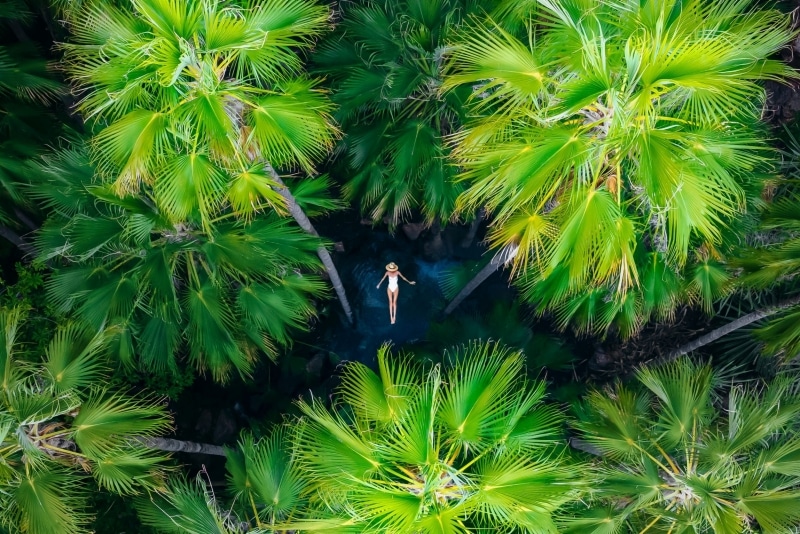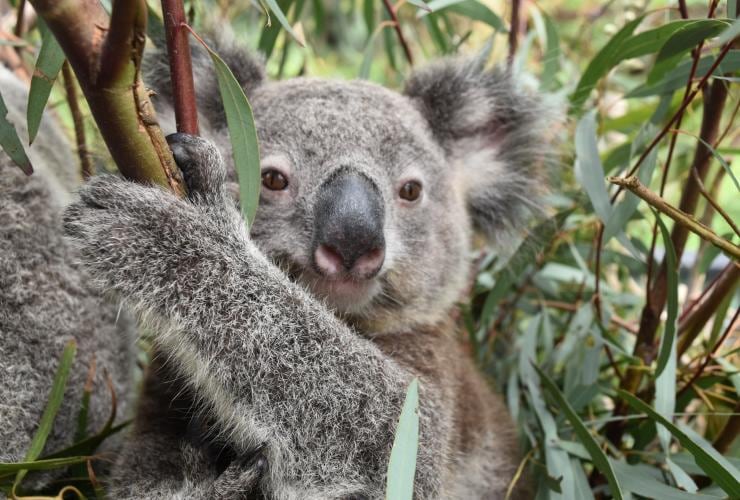
10 Fun Facts about Koalas
The cute and cuddly koala is one of Australia's most well-known (and well-loved) animals. You may know them for their fuzzy ears and large noses, but there's much more to these sleepy marsupials.
You may have heard our fluffy friends referred to as ‘koala bears’ because of their bear-like ears and big, black noses. But in fact, koalas aren’t bears at all. They are marsupials, meaning they’re more closely related to wombats and kangaroos than they are to bears.
Koalas survive on a diet of eucalyptus leaves and can eat up to a kilogram (over two pounds) a day! They may eat a lot, but they're also picky eaters. In fact, koalas eat fewer than 50 of over 700 eucalypt species. And they choose their leaves wisely – those at the top of the tallest trees contain more liquid and nutrients.
Most of a koala’s day is spent snoozing in the treetops. Because eucalyptus leaves are so low in nutrients and take a lot of time to digest, koalas need to sleep between 18 and 22 hours a day to conserve their energy.
Koalas spend most of their time sitting in eucalyptus trees, so it’s no surprise that some begin to take on the aroma. Typically, young koalas and female koalas give off a slight eucalyptus scent, which also doubles as a natural insect repellent. Meanwhile, adult male koalas have a stronger, muskier odour.
Despite their sweet appearance, koalas make one of the most unsettling sounds of the Australian bush! Male koalas use additional vocal folds to produce deep bellowing or grunting calls that can be heard several kilometres away during sunrise and sunset.
Koalas are solitary animals and stay within overlapping ‘home ranges.’ Each koala has a different sized range, depending on gender, age, social position and habitat quality. Dominant males tend to have large home ranges, and these areas are often highly respected by neighbouring koalas. Female koalas generally stay in the same territory as where they were born, while male koalas (with the exception of a few dominant and larger males) are travellers.
An infant koala is called a joey, just like a baby kangaroo. When a koala joey is born, they are the size of a peanut and even without any sight or hearing ability, they're able to use their natural instincts to immediately climb up to their mother’s pouch. Once they reach the pouch, they will remain there for the next six months while they grow and develop.
The koala is one of several Australian animals whose name derives from an Aboriginal language. The name 'koala' comes from a Darug word meaning 'no water.' This is an accurate description; koalas rarely drink from free-standing water. Instead, they stay hydrated through their diet of eucalyptus leaves and by licking rainwater that runs down the smooth bark of trees.
Koalas, on average, live up to 10 to 12 years of age in the wild. When they are 12 months old, they start to migrate away from their mother's watch and by two or three years old, they start to reproduce. Females tend to live longer (up to 18 years old) than male koalas in the wild.
Just like us, koalas have fingerprints that are completely unique to each of them. In fact, they’re so similar to human fingerprints that it’s extremely difficult to distinguish between the two species, even under a microscope. Koalas also have thumbs, but unlike us, they have two on each hand.
Spot Koalas

Lone Pine Koala Sanctuary
Experiences • Zoos, Sanctuaries, Aquariums and Wildlife Parks
Experiences
From AU$54

Koala Conservation Reserve
Experiences • Natural Attractions, Zoos, Sanctuaries, Aquariums and Wildlife Parks
Experiences
From AU$16

Port Stephens Koala Sanctuary
Retreat and Lodges • Swimming Pool
Accommodation
From AU$325 to AU$480

Tilligerry Habitat
Experiences • National Parks and Reserves
Experiences
Learn more

WILD LIFE Sydney Zoo
Experiences • Zoos, Sanctuaries, Aquariums and Wildlife Parks
Experiences
From AU$35

Port Macquarie Koala Hospital
Experiences • Zoos, Sanctuaries, Aquariums and Wildlife Parks
Experiences
From AU$5

Daisy Hill Koala Centre
Experiences • Natural Attractions, National Parks and Reserves, Zoos, Sanctuaries, Aquariums and Wildlife Parks
Experiences
Learn more

Kuranda Koala Gardens
Experiences • Zoos, Sanctuaries, Aquariums and Wildlife Parks
Experiences
From AU$21

Featherdale Sydney Wildlife Park
Experiences • Zoos, Sanctuaries, Aquariums and Wildlife Parks
Experiences
From AU$28








































































































































